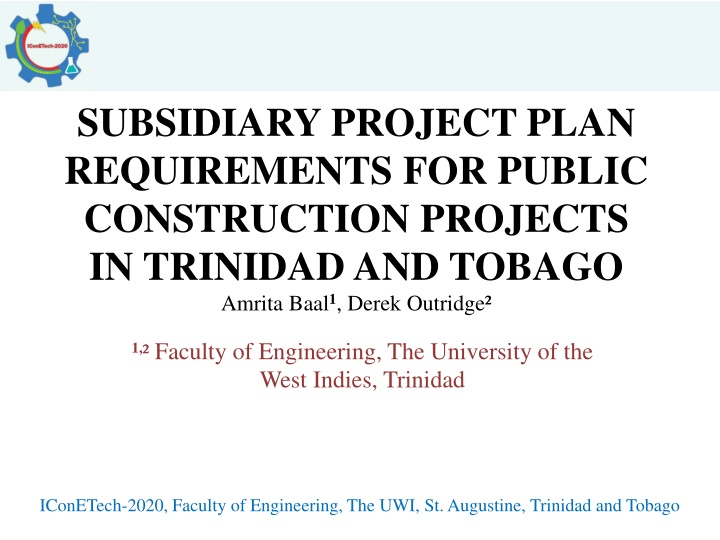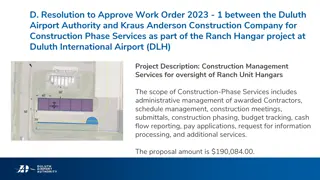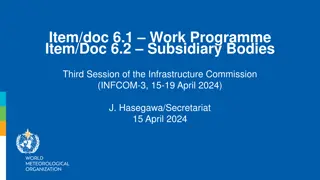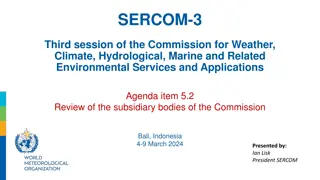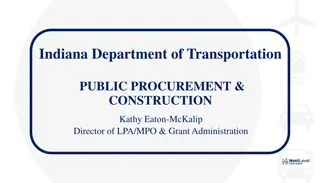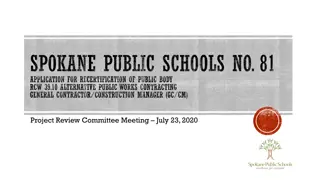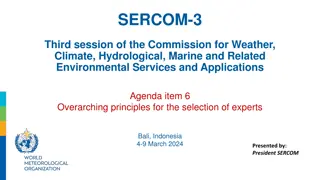Subsidiary Project Plan Requirements for Public Construction Projects in Trinidad and Tobago
Public Construction Projects in Trinidad and Tobago often face delays due to incomplete designs, errors, changes, and lack of project planning. Subsidiary Project Plans (SPPs) are essential detailed plans that guide project execution, leading to effective management and reduced cost overruns. Recommendations include creating Standard Procedure Documents to mitigate schedule delays.
Uploaded on Feb 17, 2025 | 0 Views
Download Presentation

Please find below an Image/Link to download the presentation.
The content on the website is provided AS IS for your information and personal use only. It may not be sold, licensed, or shared on other websites without obtaining consent from the author.If you encounter any issues during the download, it is possible that the publisher has removed the file from their server.
You are allowed to download the files provided on this website for personal or commercial use, subject to the condition that they are used lawfully. All files are the property of their respective owners.
The content on the website is provided AS IS for your information and personal use only. It may not be sold, licensed, or shared on other websites without obtaining consent from the author.
E N D
Presentation Transcript
SUBSIDIARY PROJECT PLAN REQUIREMENTS FOR PUBLIC CONSTRUCTION PROJECTS IN TRINIDAD AND TOBAGO Amrita Baal1, Derek Outridge 1, Faculty of Engineering, The University of the West Indies, Trinidad IConETech-2020, Faculty of Engineering, The UWI, St. Augustine, Trinidad and Tobago
INTRODUCTION Public Construction Projects (PCPs) in T&T The 2010 Uff Report found that numerous PCPs executed in T&T experienced innumerable delays amounting to as much as 4 times the original contract period, with others ranging from one to fifteen months delays. Sources of delays: - Incomplete designs - Design errors - Design Changes - The fast tracking approach IConETech-2020, Faculty of Engineering, The UWI, St. Augustine, Trinidad and Tobago
INTRODUCTION Public Construction Projects (PCPs) in T&T Indicating these delays are due to a lack of project planning at the design management stage, specifically, issues with the project s Subsidiary Project Plans (SPPs). Subsidiary Project Plans The SPPs are the smaller detailed project plans which make up the final product of the Project Management Plan during the Design Management Stage of a construction project. IConETech-2020, Faculty of Engineering, The UWI, St. Augustine, Trinidad and Tobago
INTRODUCTION Subsidiary Project Plans SPPs programs and directs the project by defining the methods to achieve project goals and deliverables, detailing all project execution plans and activities and monitoring and controlling techniques. They take into consideration all foreseeable factors and influences on the project activities, allowing for more effective management, reduced uncertainties and reduced cost/budget overruns. Examples of SPPs: Scope Management Plan, Cost Management Plan, Time Management Plan, Quality Management Plan, etc. IConETech-2020, Faculty of Engineering, The UWI, St. Augustine, Trinidad and Tobago
INTRODUCTION The Uff Report (2010) Uff and Thornhill (2010) recommended the following to aid in reducing schedule delays experienced on T&T s PCPs: The creation of Standard Procedure Documents (SPDs) for the construction industry of Trinidad and Tobago to ensure; designs are completed prior to project tendering variations be approved only for situations which were unforeseeable at the design stage and disincentives to discourage the acceptance of incomplete designs IConETech-2020, Faculty of Engineering, The UWI, St. Augustine, Trinidad and Tobago
OBJECTIVES To determine the significance of subsidiary project plans at the design stage of PCPs in T&T. To determine what SPPs are currently produced at the design stage of Public Construction Projects in T&T. To evaluate the impact the SPPs has on project schedule for T&T s Public Construction Projects. To propose an optimum set of SPPs that must be produced at the design stage of Public Construction Projects in T&T. IConETech-2020, Faculty of Engineering, The UWI, St. Augustine, Trinidad and Tobago
HYPOTHESIS Null hypothesis (H0); Subsidiary project plans are not significantly produced at the design stage of PCPs in Trinidad and Tobago. Alternative hypothesis (H1); Subsidiary project plans are significantly produced at the design stage of PCPs in Trinidad and Tobago. Variables; Independent Variable: Each Subsidiary Project Plan Dependent Variable: Project Schedule IConETech-2020, Faculty of Engineering, The UWI, St. Augustine, Trinidad and Tobago
METHODOLOGY The approach for this study was adopted from the study Comparing levels of use of project plans and performance of traditional contract and design-build construction projects in Nigeria. by Idoro (2012). Mixed Method approach was employed: Qualitative (Literature Reviews) and Quantitative (Questionnaire Surveys) research methods. IConETech-2020, Faculty of Engineering, The UWI, St. Augustine, Trinidad and Tobago
METHODOLOGY Research Design Objective 1: To determine the significance of SPPs at the design stage of PCPs in T&T. Literature Review Statistical Analysis Research Questions: 1. What subsidiary project plans are normally produced at the design stage in Public Construction Projects in Trinidad and Tobago currently? 2. What significant impact does subsidiary project plans produced at the design stage of PCPs in Trinidad and Tobago have on the overall project performance? 3. How can the use and production of subsidiary project plans at the design stage be improved to decrease project delays for PCPs in Trinidad and Tobago? Aim To determine the significance of subsidiary project plans at the design stage in Trinidad and Tobago s PCPs. Objective 2: To determine what SPPs are currently produced at the design stage of PCPs in T&T. Statistical Analysis Problem Identification Development of Research Problem Objective 3: To evaluate the impact the SPPs has on project schedule for T&T s Public Construction Projects Hypothesis Subsidiary project plans are not significantly produced at the design stage of Public Construction Projects in T&T Literature Review Statistical Analysis Independent Variable Each Subsidiary Project Plan Objective 4: To propose an optimum set of SPPs that must be produced at the design stage of Public Construction Projects in T&T. Dependent Variable Project Schedule Literature Review Statistical Analysis IConETech-2020, Faculty of Engineering, The UWI, St. Augustine, Trinidad and Tobago
METHODOLOGY Sampling Design: Population: Construction Professionals actively practicing in the industry in T&T. Sample Size: 64 responses (Kish, 1965). Data Analysis Procedures: Standard Multiple Regression Analysis (SMRA) Influence of the independent variables on the dependent variable, further used to predict a best fit model in relation to the dependent variable Hypothesis Testing: One-Way ANOVA IConETech-2020, Faculty of Engineering, The UWI, St. Augustine, Trinidad and Tobago
RESULTS Table 3: Summary of the Main Issues With SPPs in T&T and the Effects Experienced. Main Issues with SPPs in T&T s PCPs Questionnaire Survey (2010) Lack of types of SPPs produced Lack of completeness in a timely manner Lack of quality of the SPPs produced project design Main Effects Experienced Uff and Thornhill Questionnaire Survey Increased Cost and Time Uff and Thornhill (2010) Lack of timely design submission Increased Cost and Time Increased Cost and Time Incomplete/Inadequate Increased Cost and Time Increased Cost and Time IConETech-2020, Faculty of Engineering, The UWI, St. Augustine, Trinidad and Tobago
RESULTS SPPs Level of Production in Order of Their Relative Importance. Commonly Produced Yes (%) Bill of Quantities Structural Drawings Risk Management Plan Civil /Site Design Time Management Plan Cost Management Plan Mechanical Drawings Cash Flow Electrical Drawings Health and Safety Plan Architectural Drawings Scope Management Plan Quality Management Plan Relative Importance (Likert Scale) 5 5 5 5 4 4 4 4 4 4 4 4 4 Subsidiary Project Plan No (%) 48 50 77 48 64 61 52 60 47 63 50 74 81 52 50 23 52 36 39 48 40 53 37 50 26 19 Environmental Impact Assessment Report 26 74 4 Procurement Management Plan Communication Management Plan 16 19 84 81 4 4 IConETech-2020, Faculty of Engineering, The UWI, St. Augustine, Trinidad and Tobago
RESULTS SPPs Level of Production in Order of Their Relative Importance. Commonly Produced Subsidiary Project Plan Relative Importance (Likert Scale) Yes (%) No (%) Stakeholder Management Plan Logistics Plan Human Resource Management Plan Constructability Report Value Engineering Report 24 76 4 16 84 4 13 87 4 10 90 4 10 90 4 Sustainability Plan 3 97 3 Resource Histogram 8 92 3 IConETech-2020, Faculty of Engineering, The UWI, St. Augustine, Trinidad and Tobago
RESULTS Results obtained from SPSS Standard Multiple Regression Analysis. Coefficients Unstandardised Coefficients Beta ( ) 1.178 Standardised Coefficients Beta ( ) Sig. (p- value) Rank Model t Std. Error (Constant) .076 15.558 .000 1 2 3 4 5 Structural Drawings Architectural Drawings Bill of Quantities Electrical Drawings Cash Flow Procurement Management Plan .189 -.135 -.059 .060 -.054 .029 .035 .023 .022 .028 .023 .018 1.123 .932 .594 .380 .361 .218 5.338 -5.949 -2.698 2.184 -2.342 1.649 .000 .000 .010 .035 .025 .051 6 7 8 9 Mechanical Drawings Risk Management Plan Quality Management Plan Civil Stakeholder Management Plan -.031 -.027 .023 -.019 -.013 .029 .019 .024 .035 .016 .204 .165 .156 .113 .109 -1.067 -1.438 .928 -.531 -.797 .002 .000 .010 .033 .041 10 11 12 13 Constructability Report Logistics Plan -.011 -.010 .014 .018 .096 .090 -.811 -.598 .011 .067 IConETech-2020, Faculty of Engineering, The UWI, St. Augustine, Trinidad and Tobago
RESULTS Results obtained from SPSS Multiple Regression Analysis. Coefficients Unstandardised Coefficients Beta ( ) .012 -.011 .008 Standardised Coefficients Sig. (p- value ) .033 .005 .041 Rank Model t Std. Error Beta ( ) 14 15 Health and Safety Plan Value Engineering Report Human Resource Management Plan Cost Management Plan Scope Management Plan Environmental Impact Assessment Report Time Management Plan Resource Histogram Sustainability Plan Communication Management Plan .017 .019 .018 .086 .085 .074 .746 -.567 .472 16 17 18 .010 -.007 .005 .018 .017 .021 .067 .051 .034 .531 -.433 .247 .036 .002 .020 19 20 21 22 -.002 .001 .001 .001 .021 .012 .015 .019 .013 .010 .007 .005 -.094 .091 .047 .028 .000 .071 .004 .006 23 IConETech-2020, Faculty of Engineering, The UWI, St. Augustine, Trinidad and Tobago
RESULTS Optimum set of SPPs to be produced at the design stage of PCPs in T&T. Unstandardised Coefficients Std. Error 1.178 .189 -.135 -.059 .060 -.054 .029 -.031 -.027 .023 -.019 -.013 -.011 -.010 .012 -.011 Standardised Coefficients t Sig. Rank Model (Constant) Structural Drawings Architectural Drawings Bill of Quantities Electrical Drawings Cash Flow Procurement Management Plan Mechanical Drawings Risk Management Plan Quality Management Plan Civil/Site Design Stakeholder Management Plan Constructability Report Logistics Plan Health and Safety Plan Value Engineering Report .076 .035 .023 .022 .028 .023 .018 .029 .019 .024 .035 .016 .014 .018 .017 .019 15.558 5.338 -5.949 -2.698 2.184 -2.342 1.649 -1.067 -1.438 .928 -.531 -.797 -.811 -.598 .746 -.567 .000 .000 .000 .010 .035 .025 .108 .293 .159 .359 .599 .431 .423 .553 .460 .574 1 2 3 4 5 6 7 8 9 1.123 .932 .394 .380 .361 .218 .204 .165 .156 .113 .109 .096 .090 .086 .085 10 11 12 13 14 15 IConETech-2020, Faculty of Engineering, The UWI, St. Augustine, Trinidad and Tobago
RESULTS Results of the One-Way ANOVA test on the hypothesis of the study Sum of Squares Mean Square df F Sig. Between Groups Within Groups Total The resulting p-value of 0.522 (>0.05) indicating no significant difference between the means of the levels of production of SPPs in T&T. The null hypothesis (Ho) of this study failed to be rejected, proving that SPPs are not significantly produced at the design stage of PCPs in T&T. .089 1 .089 .415 .522 12.600 59 .214 12.689 60 IConETech-2020, Faculty of Engineering, The UWI, St. Augustine, Trinidad and Tobago
CONCLUSION In investigating the sources of these severe issues identified in the Uff Report, it was determined to be the lack of SPPs developed at the design stage of projects. This study revealed that significant SPPs are not produced at the design stage of PCPs in T&T. As a result, this study proposes A minimum set of SPPs to be produced at the design stage of PCPs in T&T, for standardisation. IConETech-2020, Faculty of Engineering, The UWI, St. Augustine, Trinidad and Tobago
RECOMMENDATIONS Standardise the optimum set of 15 SPPs presented in the results making it a minimum requirement for all PCPs in T&T prior to project tendering. Further research in investigating the remaining six factors identified in the Uff Report; Inadequate/Inaccurate soil investigations Lack of project data Lack of design review Invalid project information Failure to carry out adequate site investigations Lack of supervision/management IConETech-2020, Faculty of Engineering, The UWI, St. Augustine, Trinidad and Tobago
THANK YOU Please forward all questions to amritabaal@hotmail.com / derek.outridge@sta.uwi.edu Or WhatsApp @ 1-868-770-7934 IConETech-2020, Faculty of Engineering, The UWI, St. Augustine, Trinidad and Tobago
REFERENCES Assaf, S.A. 2006. Causes of Delay in Large Construction Projects. International Journal of Project Management 24, 349-357. Chung, E. 2014. PMP Certification Essentials The Project Management Plan (PM Plan) Explained. Idoro, G. 2012. Comparing Levels of Use of Project Plans and Performance of Traditional Contract and Design-Build Construction Projects in Nigeria. Journal of Engineering, Design and Technology Vol. 10 No. 1, 7-33. Menches, C. 2006. Effect of Pre-construction Planning on Electrical Project Performance. PhD Diss., University of Wisconsin. Uff, J. & Thornhill, D. 2010. Report of The Commission of Enquiry into the Construction Sector Trinidad and Tobago. Trinidad and Tobago: The Government of the Republic of Trinidad and Tobago. IConETech-2020, Faculty of Engineering, The UWI, St. Augustine, Trinidad and Tobago
